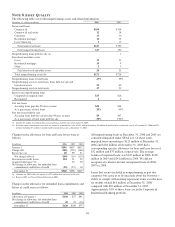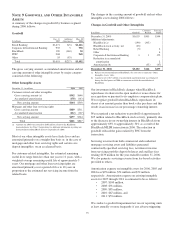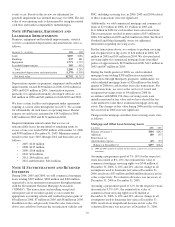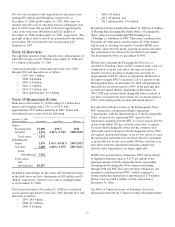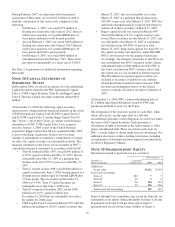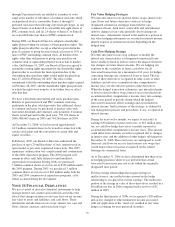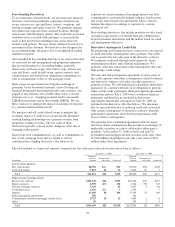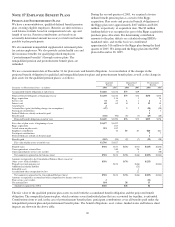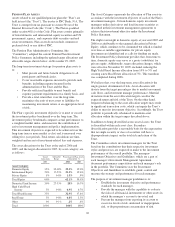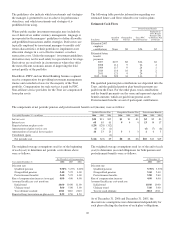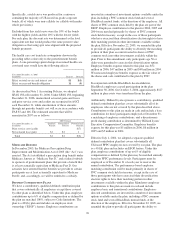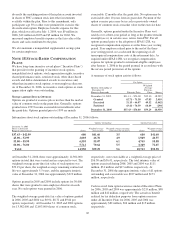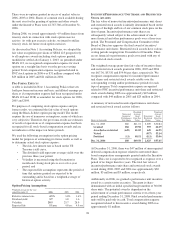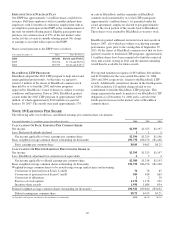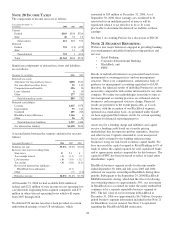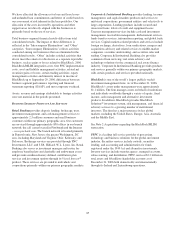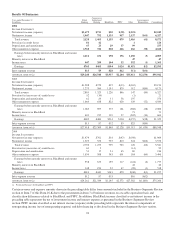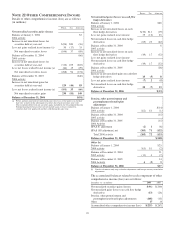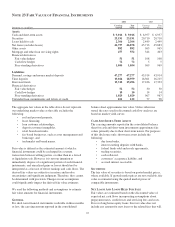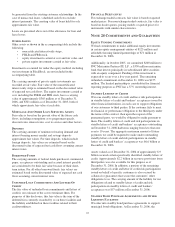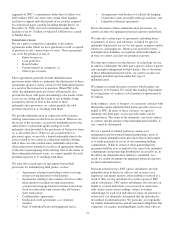PNC Bank 2006 Annual Report Download - page 114
Download and view the complete annual report
Please find page 114 of the 2006 PNC Bank annual report below. You can navigate through the pages in the report by either clicking on the pages listed below, or by using the keyword search tool below to find specific information within the annual report.
Specifically, a yield curve was produced for a universe
containing the majority of US-issued Aa grade corporate
bonds, all of which were non-callable (or callable with make-
whole provisions).
Excluded from this yield curve were the 10% of the bonds
with the highest yields and the 10% with the lowest yields.
For each plan, the discount rate was determined as the level
equivalent rate that would produce the same present value
obligation as that using spot rates aligned with the projected
benefit payments.
The health care cost trend rate assumptions shown in the
preceding tables relate only to the postretirement benefit
plans. A one-percentage-point change in assumed health care
cost trend rates would have the following effects:
Year ended December 31, 2006
In millions Increase Decrease
Effect on total service and interest cost $1 $(1)
Effect on year-end benefit obligation 11 (9)
As discussed in Note 1 Accounting Policies, we adopted
SFAS 158 at December 31, 2006. Under SFAS 158, beginning
December 31, 2006, unamortized actuarial gains and losses
and prior service costs and credits are recognized in AOCI
each December 31, while amortization of these amounts
through net periodic benefit cost will occur in accordance with
FAS 87 and 106. The estimated amounts that will be
amortized in 2007 are as follows:
2007 Estimate
Year ended December 31
In millions
Qualified
Pension
Nonqualified
Pension
Postretirement
Benefits
Prior service cost (credit) $(7)
Net actuarial loss (gain) $1 $2 1
Total $1 $2 $(6)
M
EDICARE
R
EFORM
In December 2003, the Medicare Prescription Drug
Improvement and Modernization Act of 2003 (the “Act”) was
enacted. The Act established a prescription drug benefit under
Medicare, known as “Medicare Part D,” and a federal subsidy
to sponsors of postretirement plans that provide a benefit that
is at least actuarially equivalent to Medicare Part D. Our
actuaries have attested that the benefits we provide to certain
participants are at least actuarially equivalent to Medicare
Part D, and, accordingly, we will be entitled to a subsidy.
D
EFINED
C
ONTRIBUTION
P
LANS
We have a contributory, qualified defined contribution plan
that covers substantially all employees except those covered
by other plans as identified below. Under this plan, employee
contributions up to 6% of eligible compensation as defined by
the plan are matched 100%, subject to Code limitations. The
plan is a 401(k) plan and includes an employee stock
ownership (“ESOP”) feature. Employee contributions are
invested in a number of investment options available under the
plan, including a PNC common stock fund and several
BlackRock mutual funds, at the direction of the employee. All
shares of PNC common stock held by the plan are part of the
ESOP. Employee contributions to the plan for 2006, 2005 and
2004 were matched primarily by shares of PNC common
stock held in treasury, except in the case of those participants
who have exercised their diversification election rights to have
their matching portion in other investments available within
the plan. Effective November 22, 2005, we amended the plan
to provide all participants the ability to diversify the matching
portion of their plan account invested in shares of PNC
common stock into other investments available within the
plan. Prior to this amendment, only participants age 50 or
older were permitted to exercise this diversification option.
Employee benefits expense related to this plan was $52
million in 2006, $47 million in 2005 and $48 million in 2004.
We measured employee benefits expense as the fair value of
the shares and cash contributed to the plan by PNC.
In conjunction with the BlackRock deconsolidation,
BlackRock employees ceased participating in the plan
September 30, 2006. On October 3, 2006, approximately $127
million in plan assets were transferred from the plan.
Additionally, Hilliard Lyons sponsors a contributory, qualified
defined contribution plan that covers substantially all of its
employees who are not covered by the plan described above.
Contributions to this plan are made in cash and include a base
contribution for those participants employed at December 31,
a matching of employee contributions, and a discretionary
profit sharing contribution as determined by Hilliard Lyons’
Executive Compensation Committee. Employee benefits
expense for this plan was $5 million in 2006, $6 million in
2005 and $5 million in 2004.
Effective July 1, 2004, we adopted a separate qualified
defined contribution plan that covers substantially all
US-based PFPC employees not covered by our plan. The plan
is a 401(k) plan and includes an ESOP feature. Under this
plan, employee contributions of up to 6% of eligible
compensation as defined by the plan may be matched annually
based on PFPC performance levels. Participants must be
employed as of December 31 of each year to receive this
annual contribution. The performance-based employer
matching contribution will be made primarily in shares of
PNC common stock held in treasury, except in the case of
those participants who have exercised their diversification
election rights to have their matching portion in other
investments available within the plan. Mandatory employer
contributions to this plan are made in cash and include
employer basic and transitional contributions. Employee-
directed contributions are invested in a number of investment
options available under the plan, including a PNC common
stock fund and several BlackRock mutual funds, at the
direction of the employee. Effective November 22, 2005, we
amended the plan to provide all participants the ability to
104


